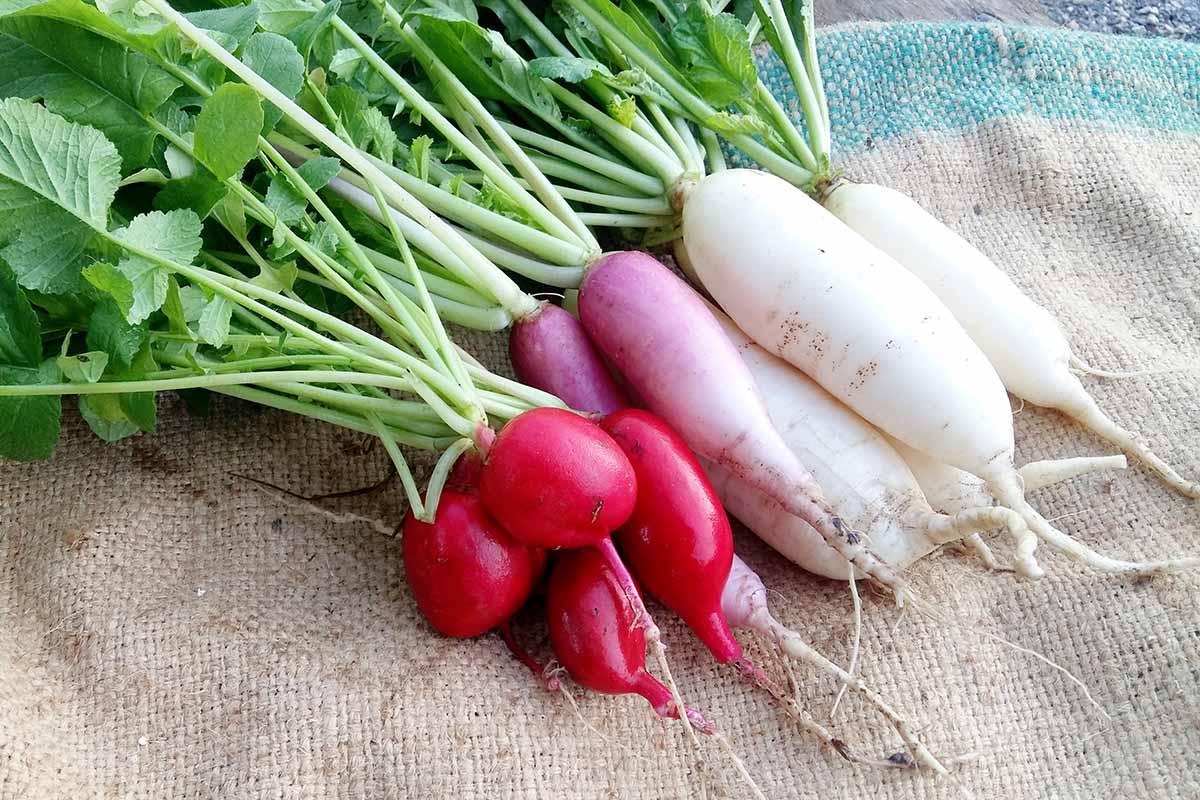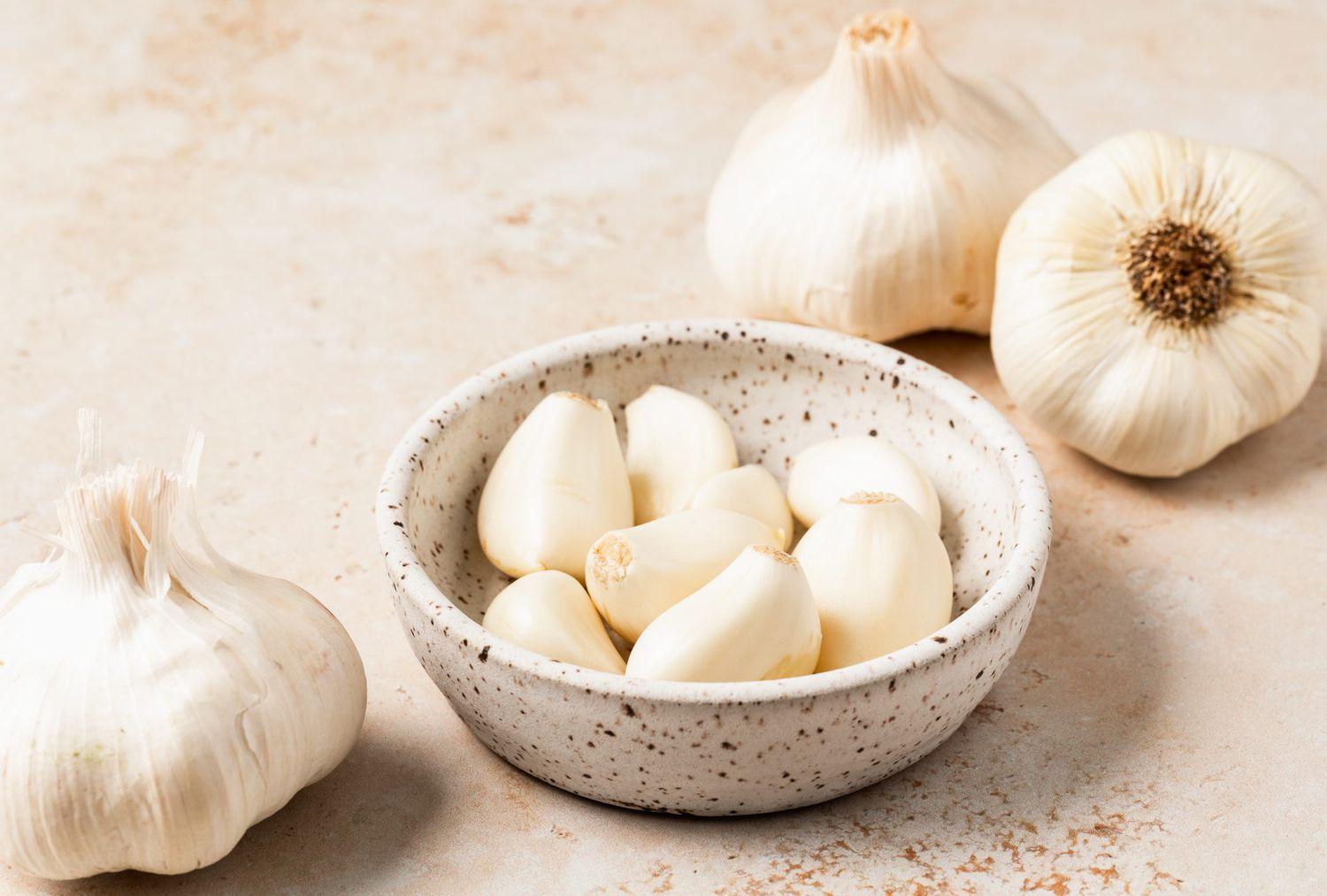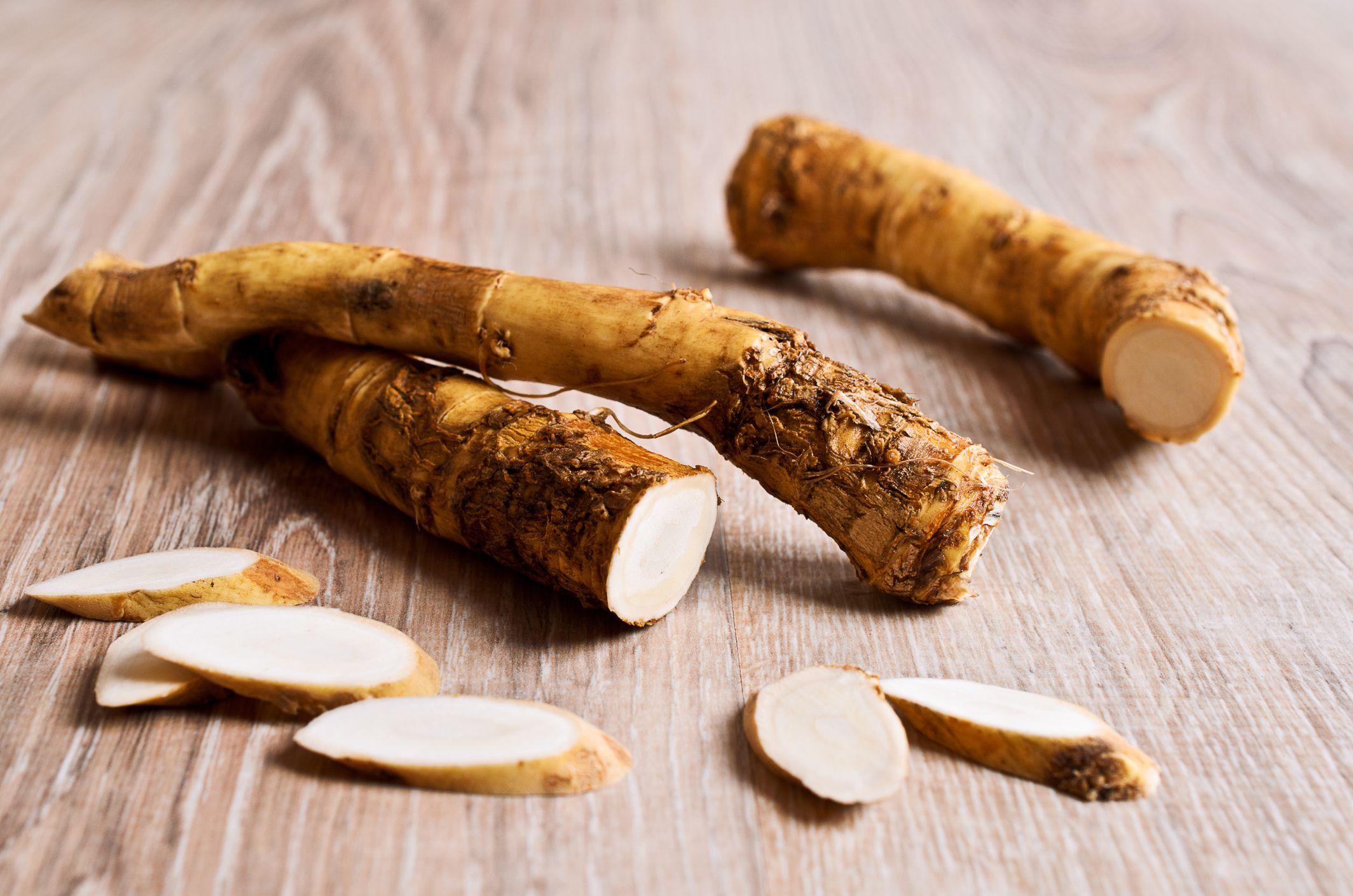25 Popular Root Vegetables Around the World

Root vegetables are a big part of many cuisines worldwide, but most people only know a handful of common ones.
I get it – I used to stick to potatoes and carrots, too. But there’s a whole world of tasty and healthy root veggies out there waiting to be tried!
In this post, I’ll introduce you to 25 root vegetables from around the globe. You’ll learn about their flavors and textures and how to use them in cooking.
By the end, you’ll have many new ingredients to experiment with in your kitchen.
Let’s dig into the delicious world of root vegetables together!
List of Root Vegetables to Explore
1. Carrot

Carrots are widely cultivated root vegetables from Persia. They are known for their vibrant orange color, crisp texture, and sweet taste.
- Nutritional Value: Rich in beta-carotene, fiber, vitamin K1, and antioxidants.
- Culinary Uses: Eaten raw in salads, cooked in soups, or roasted as a side dish.
- Growing Tips: Thrive in well-drained, sandy soil with full sunlight.
- Availability: Available year-round, with peak season in the summer.
- Fun Facts: Carrots were originally purple before orange varieties became popular.
2. Beetroot

Beetroots are a deep red or purple root vegetable native to the Mediterranean. They have a sweet, earthy flavor and a tender texture.
- Nutritional Value: High in folate, fiber, iron, and vitamin C.
- Culinary Uses: Commonly roasted, boiled, or used raw in salads and juices.
- Growing Tips: Prefers well-drained, fertile soil and full sun exposure.
- Availability: Best in spring and fall, though available year-round.
- Fun Facts: Beetroots can be used as a natural dye due to their strong pigmentation.
3. Sweet Potato

Sweet potatoes, originating from Central and South America, are starchy root vegetables with a naturally sweet flavor and a creamy texture.
- Nutritional Value: High in vitamin A, fiber, and potassium.
- Culinary Uses: It can be baked, mashed, or fried and is often used in both savory and sweet dishes.
- Growing Tips: Grows best in warm, sandy soil with plenty of sunlight.
- Availability: Available throughout the year, with a peak season in the fall.
- Fun Facts: Sweet potatoes are often confused with yams, though they are botanically different.
4. Turnip

Turnips are a round, white root vegetable with a slightly bitter taste, originally from Middle and Northern Europe.
- Nutritional Value: Good source of vitamin C, potassium, and dietary fiber.
- Culinary Uses: Often boiled, mashed, or roasted, young leaves can be eaten as greens.
- Growing Tips: Prefers cool climates and well-drained soil.
- Availability: Generally available in the fall and winter.
- Fun Facts: Turnips were a food source long before potatoes became popular in Europe.
5. Radish

Radishes are small, crunchy root vegetables with a sharp, peppery flavor, believed to have originated in Southeast Asia.
- Nutritional Value: Low in calories, high in vitamin C and antioxidants.
- Culinary Uses: Commonly eaten raw in salads, pickled, or as a garnish.
- Growing Tips: Grow quickly in well-drained soil with full sun.
- Availability: Available year-round, with peak seasons in spring and fall.
- Fun Facts: The ancient Egyptians believed radishes were a valuable crop, often paid as wages.
6. Parsnip

Parsnips are cream-colored root vegetables native to the Mediterranean. They have a sweet, nutty flavor that intensifies when cooked.
- Nutritional Value: High in fiber, vitamin C, and potassium.
- Culinary Uses: Often roasted, mashed, or used in soups and stews.
- Growing Tips: Prefers cooler climates and well-drained, fertile soil.
- Availability: Best in the winter, with a peak season after the first frost.
- Fun Facts: Parsnips were once more popular than potatoes in Europe.
7. Yam

Yams are large, starchy root vegetables originally from Africa and Asia. They have rough, brown skin and a mildly sweet flavor.
- Nutritional Value: Rich in carbohydrates, vitamin C, and dietary fiber.
- Culinary Uses: Boiled, mashed, or fried; commonly used in both savory and sweet dishes.
- Growing Tips: Requires a long growing season in warm climates.
- Availability: Available year-round, with peak seasons in the fall and winter.
- Fun Facts: Yams and sweet potatoes are often confused, but they are botanically distinct.
8. Cassava

Cassava, also known as yuca, is a starchy root vegetable native to South America. It has a mild flavor and fibrous texture.
- Nutritional Value: High in carbohydrates and vitamin C, but low in protein.
- Culinary Uses: Boiled, fried, or ground into flour for bread and other dishes.
- Growing Tips: Thrives in tropical climates with well-drained soil.
- Availability: Generally available in tropical regions year-round.
- Fun Facts: Cassava is the source of tapioca, a common thickening agent in cooking.
9. Taro

Taro is a starchy root vegetable with brown, fibrous skin and a slightly sweet, nutty flavor, originating from Southeast Asia.
- Nutritional Value: Rich in dietary fiber, potassium, and vitamins E and C.
- Culinary Uses: Boiled, mashed, or used in soups and desserts.
- Growing Tips: Requires moist, well-drained soil and a warm, humid climate.
- Availability: Available year-round in tropical and subtropical regions.
- Fun Facts: Taro is a staple food in many Pacific Islander diets and is used to make poi, a traditional Hawaiian dish.
10. Ginger

Ginger is a spicy, aromatic root vegetable native to Southeast Asia, widely used for its medicinal properties and strong, zesty flavor.
- Nutritional Value: Contains gingerol, a compound with potent antioxidant and anti-inflammatory effects.
- Culinary Uses: Used fresh, dried, or powdered in cooking, teas, and medicinal remedies.
- Growing Tips: Thrives in warm, humid climates with well-drained soil.
- Availability: Available year-round, particularly in tropical and subtropical regions.
- Fun Facts: Ginger has been used in traditional medicine for thousands of years to treat various ailments.
11. Onion

Onions are versatile root vegetables with an intense flavor and aroma, originating from Central Asia.
- Nutritional Value: High in vitamin C, B vitamins, and various antioxidants.
- Culinary Uses: Used in almost every cuisine worldwide, both raw and cooked.
- Growing Tips: Grows best in well-drained soil with full sun exposure.
- Availability: Available year-round, with peak seasons in the summer and fall.
- Fun Facts: Onions have been cultivated for over 5,000 years and were even used as currency in ancient Egypt.
12. Garlic

Garlic is a pungent root vegetable with a strong, distinctive flavor, native to Central Asia.
- Nutritional Value: Rich in vitamins C and B6, manganese, and selenium.
- Culinary Uses: Used as a flavoring in cooking and for its medicinal properties.
- Growing Tips: Prefers well-drained soil and full sun; best planted in the fall.
- Availability: Available year-round, with a peak harvest in the summer.
- Fun Facts: Garlic was historically used to ward off evil spirits and is still believed to have protective properties in some cultures.
13. Horseradish

Horseradish is a root vegetable with a hot, peppery flavor, originally from Eastern Europe.
- Nutritional Value: Contains glucosinolates, which have antioxidant properties.
- Culinary Uses: Grated and used as a condiment or in sauces.
- Growing Tips: Thrives in rich, moist soil with full sun or partial shade.
- Availability: Available year-round, though best harvested in the fall.
- Fun Facts: Horseradish has been used as a spice and medicinal plant since ancient times.
14. Daikon

Daikon is a large, white radish with a mild flavor and crisp texture commonly used in East Asian cuisine.
- Nutritional Value: High in vitamin C, potassium, and fiber.
- Culinary Uses: Eat raw in salads, pickled, or used in soups and stews.
- Growing Tips: Prefers cool weather and well-drained soil.
- Availability: Best in the winter, though available year-round in some regions.
- Fun Facts: Daikon is often used in Japanese cuisine as a garnish and digestive aid.
15. Jerusalem Artichoke

Jerusalem artichokes, also known as sunchokes, are knobby, brown-skinned root vegetables native to North America with a nutty, sweet flavor.
- Nutritional Value: Rich in iron, potassium, and inulin, a type of fiber.
- Culinary Uses: Can be roasted, sautéed, or eaten raw in salads.
- Growing Tips: Grows best in well-drained soil with plenty of sunlight.
- Availability: Available in the fall and winter.
- Fun Facts: Despite its name, the Jerusalem artichoke is not related to artichokes and does not come from Jerusalem.
16. Rutabaga

Rutabagas are round, yellow-fleshed root vegetables with a sweet, slightly bitter flavor, believed to be a cross between a cabbage and a turnip.
- Nutritional Value: High in vitamin C, fiber, and potassium.
- Culinary Uses: Often boiled, mashed, or roasted, it can also be used in soups.
- Growing Tips: Prefers cool climates and well-drained, fertile soil.
- Availability: Best in the fall and winter.
- Fun Fact: Due to their popularity in Sweden, rutabagas are known in some regions as “Swedes.”
17. Celeriac

Celeriac, also known as celery root, is a knobby, bulbous root vegetable with a mild, celery-like flavor, originating from the Mediterranean Basin.
- Nutritional Value: Good source of vitamin K, fiber, and potassium.
- Culinary Uses: Can be mashed, roasted, or used in soups and stews.
- Growing Tips: Thrives in cool climates with moist, well-drained soil.
- Availability: Available in the fall and winter.
- Fun Facts: Celeriac is a popular ingredient in French cuisine, often used in the classic dish celeriac remoulade.
18. Burdock Root

Burdock root is a long, slender root vegetable with a slightly sweet, earthy flavor. It is commonly used in traditional Asian and herbal medicine.
- Nutritional Value: High in fiber, potassium, and magnesium.
- Culinary Uses: Used in soups, stews, or stir-fried; also used in herbal teas.
- Growing Tips: Prefers well-drained, sandy soil and full sun.
- Availability: Available year-round, particularly in Asian markets.
- Fun Facts: Burdock root is a key ingredient in traditional Japanese dishes like kinpira gobo.
19. Lotus Root

Lotus root is an aquatic root vegetable with a crunchy texture and mildly sweet flavor, native to Asia.
- Nutritional Value: Rich in dietary fiber, vitamin C, and potassium.
- Culinary Uses: Commonly used in stir-fries, soups, and salads.
- Growing Tips: Requires a warm, humid climate and shallow water to grow.
- Availability: Available year-round in Asian markets, with peak seasons in the fall and winter.
- Fun Facts: The lotus plant is highly symbolic in Asian cultures, often representing purity and enlightenment.
20. Kohlrabi

Kohlrabi is a bulbous root vegetable from Europe. It has a mild, sweet flavor and crisp texture. It belongs to the cabbage family.
- Nutritional Value: High in vitamin C, fiber, and potassium.
- Culinary Uses: Can be eaten raw, roasted, or used in soups and salads.
- Growing Tips: Thrives in cool weather with well-drained soil.
- Availability: Available year-round, with peak seasons in the spring and fall.
- Fun Facts: Kohlrabi’s name comes from the German words “kohl” (cabbage) and “rabi” (turnip).
21. Turmeric

Turmeric is a vibrant orange root vegetable with a warm, bitter flavor. It is native to South Asia and is widely used in cooking and traditional medicine.
- Nutritional Value: Contains curcumin, a powerful antioxidant with anti-inflammatory properties.
- Culinary Uses: Used fresh or dried as a spice in curries, teas, and sauces.
- Growing Tips: Thrives in warm, humid climates with well-drained soil.
- Availability: Available year-round, particularly in tropical and subtropical regions.
- Fun Facts: Turmeric has been used as a dye and medicinal herb for thousands of years in India.
22. Jicama

Jicama is a large, round root vegetable native to Mexico. It has a crisp texture and a mildly sweet, nutty flavor.
- Nutritional Value: High in fiber, vitamin C, and water content.
- Culinary Uses: Eat raw in salads, salsas, or as a snack; also used in stir-fries.
- Growing Tips: Prefers warm, sunny climates with well-drained soil.
- Availability: Available year-round, particularly in Latin American markets.
- Fun Facts: Jicama is often referred to as the “Mexican potato” due to its popularity in Mexican cuisine.
23. Salsify

Salsify is a long, thin root vegetable with a mild, oyster-like flavor, native to the Mediterranean region.
- Nutritional Value: High in fiber, vitamin C, and potassium.
- Culinary Uses: Often boiled, mashed, or used in soups and stews.
- Growing Tips: Prefers cool weather and well-drained, sandy soil.
- Availability: Available in the fall and winter.
- Fun Facts: Salsify is sometimes called “oyster plant” due to its unique flavor.
24. Wasabi

Wasabi is a pungent root vegetable native to Japan, known for its sharp, spicy flavor commonly used in Japanese cuisine.
- Nutritional Value: Contains isothiocyanates, which have antibacterial properties.
- Culinary Uses: Grated fresh and used as a condiment, particularly with sushi and sashimi.
- Growing Tips: Requires a specific environment with clean, cold water and partial shade.
- Availability: Fresh wasabi is rare and expensive, often replaced by horseradish-based substitutes.
- Fun Facts: True wasabi is difficult to grow and is considered a delicacy in Japan.
25. Valerian

Valerian is a perennial herb with a long, slender root native to Europe and parts of Asia. It has a strong, earthy aroma and a slightly bitter taste.
- Nutritional Value: Contains magnesium, calcium, and various antioxidants.
- Culinary Uses: Young leaves can be used in salads or as a garnish.
- Growing Tips: Thrives in moist, well-drained soil in partial shade.
- Availability: Generally available during spring and summer when the plant is actively growing.
- Fun Facts: Valerian root has been used for centuries as a natural remedy for insomnia and anxiety.
Conclusion
Now that we’ve dug into 25 root vegetables worldwide, I hope you’re excited to try some new flavors in your kitchen. Remember, each of these veggies brings its own unique taste and texture to your meals.
Why does this matter? Well, adding variety to your diet isn’t just about new tastes – it’s about getting a wider range of nutrients too. Plus, it’s a fun way to connect with different cultures through food.
What’s next? I’d love for you to pick one new root vegetable from this list and give it a try. Share your experience in the comments below – what did you cook, and how did it taste?
Your story might inspire someone else to try something new, too!






